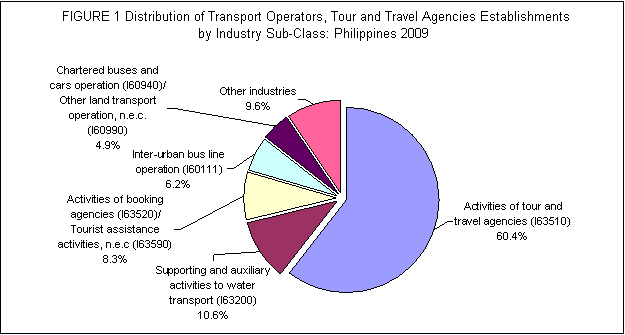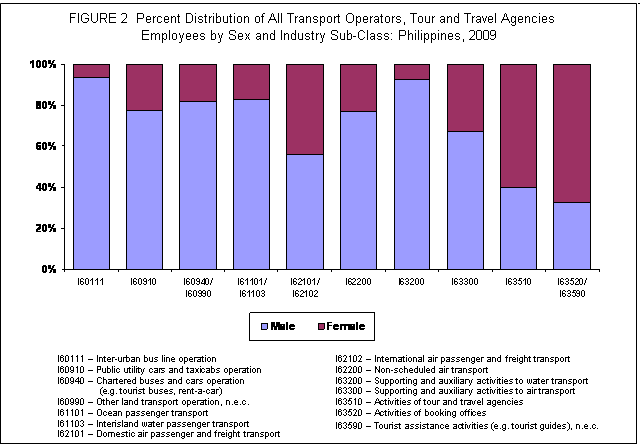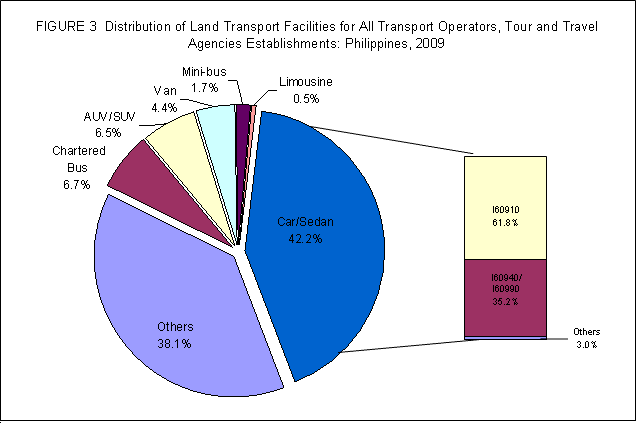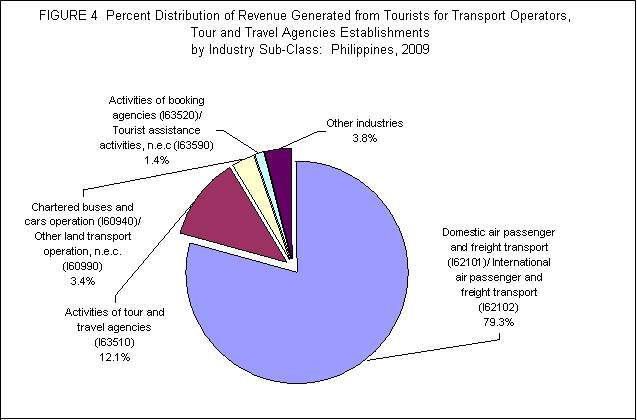Activities of tour and travel agencies account for the biggest number of establishments
Based on the results of the 2009 Survey of Tourism Establishments in the Philippines, there were 1,430 establishments engaged in Transport operators, tour and travel agencies for all employment sizes. As shown in Figure 1, 864 establishments or 60.4 percent operated under Activities of tour and travel agencies (I63510). This was followed by Supporting and auxiliary activities to water transport industry (I63200) with 152 establishments or 10.6 percent. Activities of booking offices (I63520)/Tourist assistance activities, not elsewhere classified (I63590) recorded 119 establishments or 8.3 percent. On the other hand, only five establishments operated under Domestic air passenger and freight transport (I62101)/International air passenger and freight transport (I62102).

Transport operators, tour and travel agencies is a male-dominated industry in terms of employment
Transport operators, tour and travel agencies reported a total of 67,974 employees in 2009. One in every two employees was employed either in Inter-urban bus line operation (I60111) or Supporting and auxiliary activities to water transport (I63200). Domestic air passenger and freight transport (I62101)/International air passenger and freight transport (I62102) placed third with 11,372 employees or 16.7 percent. The least number of workers was found in Non-scheduled air transport (I62200) with 343 or 0.5 percent.
All industries hired more men than women except for Activities of tour and travel agencies (I63510) and Activities of booking offices (I63520)/Tourist assistance activities, not elsewhere classified (I63590). In 2009, 77.2 percent of the total employment were male employees. Figure 2 shows the distribution of employees by sex.

Majority of the workers (99.4%) under Transport operators, tour and travel agencies were Filipinos. Only 392 workers or 0.6 percent were non-Filipinos. Of the total number of employed non-Filipinos, Domestic air passenger and freight transport (I62101)/International air passenger and freight transport (I62102) employed the highest percentage with 80.9 percent.
Total number of tour guides registered at 1,012, of which 74.3 percent were hired by Activities of tour and travel agencies (I63510). One out of three tour guides were freelancers or on commission basis. No tour guides were reported in Public utility cars and taxicabs operation (I60910), Domestic air passenger and freight transport (I62101)/International air passenger and freight transport (I62102), Supporting and auxiliary activities to water transport (I63200), and Supporting and auxiliary activities to air transport (I63300).
One out of two establishments offers On-line booking/reservation and Tour packaging services
About 67.6 percent of the total number of establishments reported to have at least one available facility for clients/guests use in 2009. On-line booking/reservation emerged as the top facility as five out of ten establishments offered it.
In terms of available services, 1,226 establishments or 85.7 percent reported to have at least one available service for clients/guests use. Tour packaging services is the most common service being offered by establishments comprising 53.7 percent of the total available services.
Cars/sedans, passenger ships and airplanes are the most common transport facilities
About 5,319 units or 42.2 percent of the total land transport facilities owned and operated by the establishments were cars/sedans. More than half of this or 3,285 cars/sedans were utilized in Public utility cars and taxicabs operation industry (I60910). Distribution of land transport facilities is shown in Figure 3.

Passenger ship, the most common water transport facilities used in 2009, was accounted for 147 units or 42.7 percent of the total water transport facilities. This was followed by Other water transport facilities and Ferry with 23.3 percent and 17.2 percent, respectively.
Almost all (97.4%) of the total 193 units of air transport facilities were operated by Domestic air passenger and freight transport (I62101)/International air passenger and freight transport (I62102) and Non-scheduled air transport (I62200). Of the total air transport facilities, 178 units or 92.2 percent were airplanes.
Domestic air passenger and freight transport/International air passenger and freight transport contribute the biggest share in revenue generated from tourists
Transport operators, tour and travel agencies reported a total revenue of PhP164.5 billion of which 41.6 percent were generated from tourists. Among industries, Domestic air passenger and freight transport (I62101)/International air passenger and freight transport (I62102) earned both the highest total revenue and revenue generated from tourists with PhP97.1 billion and PhP54.3 billion, respectively.
All the revenues reported by Chartered buses and cars operation (I60940), Activities of tour and travel agencies (I63510), Activities of booking offices (I63520), and Tourist assistance activities, not elsewhere classified (I63590) were generated from tourists. Figure 4 shows the percent distribution of revenue generated from tourists.

Activities of tour and travel agencies lead in plans for expansion and renovation
One out of ten establishments answered "Yes" when asked whether they have plans for expansion within the next five years. More than half of those who said "Yes" were from Activities of tour and travel agencies (I63510).
Same result was found when establishments were asked whether they have plans for renovation within the next five years. About one out of ten establishments answered "Yes" and 53.6 percent of those who said "Yes" were from Activities of tour and travel agencies (I63510).
Small number of establishments has DOT accreditation in 2009
Only 194 establishments or 13.6 percent of the total were accredited by Department of Tourism (DOT) in 2009. More than half of the total establishments with DOT accreditation in 2009 were under Activities of tour and travel agencies (I63510).
TECHNICAL NOTES
Introduction
The National Statistics Office (NSO) conducted the first-ever 2009 Survey of Tourism Establishments in the Philippines (STEP). This survey collected information on the available supply of tourism goods, products and services which are valuable inputs in the compilation of the Philippine Tourism Satellite Account (PTSA). This is a nationwide survey of establishments in the formal sector engaged in tourism characteristic industries only as defined by Philippine Tourism Statistical Classification System (PTSCS). Tourism characteristic products are goods and services which would cease to exist in meaningful quantity or those for which the level of consumption would be significantly reduced in the absence of visitors (e.g. accommodation services). Activities from which the products were created are termed as tourism characteristic industries..
Scope and coverage
The 2009 STEP is a nationwide survey of establishments in the formal sector engaged in tourism characteristic industries only, as well as, health and wellness industries. Identified industries for health and wellness are included due to the increasing demand for statistics on these activities.
The 2009 STEP covered completely four tourism characteristic industries namely:
- Hotels and motels (H55110)
- Pension houses (H55191)
- Other short-stay accommodation (H55199)
- Transport equipment rental
Also included for scope and coverage of 2009 STEP are those establishments engaged in the following:
- Accommodation (H55120, H55192)
- Restaurant (H552)
- Passenger transport
- Transport equipment rental
- Travel agency, tour operator and tourist guide services
- Recreation, entertainment, cultural services and similar activities
- Financial and insurance activities
- Health and wellness
Response rate
A total of 467 or 89.3 percent of the sample establishments responded. These include receipts of "good" questionnaires, partially accomplished questionnaires and reports of closed, moved out or out of scope establishments.
CONCEPTS AND DEFINITIONS OF TERMS
Tourism refers to activities of foreign and domestic visitors traveling to and staying in places outside their usual environment for not more than one continuous year for leisure, business and other purposes not related to employment with pay from within the place visited. Traveling for the purpose of conducting businesses, for education and training, etc., can also be part of tourism. Both foreign visitors (country of residence is other than the Philippines) and domestic visitors (Philippine residents) are covered in the survey.
Tourism activities encompass all that foreign and domestic visitors do for a trip or while on a trip. It is not restricted to what could be considered as "typical" tourism activities such as sightseeing, sunbathing, visiting site, etc. From an economic point of view, the basic activity of foreign and domestic visitors is consumption, that is, the acquisition of consumption goods and services to satisfy individual or collective needs and wants.
Tourist/visitor is a person traveling to a place, that is his/her not usual environment for less than 12 months and whose main purpose of the trip does not involve economic activity remunerated within the place visited.
Accreditation is a certification issued by the Department of Tourism which recognizes the holder to having complied with its minimum standards in the operation of the establishment concerned.
Airplane is an aircraft used to transport passengers and cargo by air.
Air Transport refers to the transportation of persons, property, mail or cargo by aircraft.
AUV/SUV (Asian Utility Vehicle/Sport Utility Vehicle) is a four-wheel-drive vehicle used for travel but most suitable for rough terrain.
Bus is a vehicle with a minimum of 25 seating capacity.
Car/Sedan is a vehicle with a maximum seating capacity of five including driver.
Dockyard-Shipyards and dockyards refer to areas where ships (e.g. yachts, military vessels, cruise liners or other cargo or passenger ships) are repaired and built. Dockyards are sometimes more associated with maintenance and basing activities than shipyards, which are sometimes associated more with initial construction.
Electronic payment (e.g. credit card, ATM) and dockyards refers to money paid electronically. Also known as e-money, electronic cash, electronic currency, digital money, digital cash or digital currency.
Ferry refers to any vessel having provision only for deck as defined in the Philippine Merchant Marine Rules and Regulations (PMMRR).
Foreign exchange counter is a business establishment whose customers exchange one currency for another.
Helicopter is a type of rotorcraft in .which lift and thrust are supplied by one or more engine driven rotors. In contrast with fixed-wing aircraft, which allows the helicopter to take off and land vertically, to hover, and to fly forwards, backwards and laterally.
Land transport is the movement of persons and goods on or across land by means of any conveyance and through the use of the infrastructure and facilities in connection therewith.
Limousine or limo is a luxury vehicle sedan or saloon car, especially one with a lengthened wheelbase or driven by a chauffeur.
Mini-Bus is a vehicle with a minimum of 16 to a maximum of 24 seating capacity.
Motorboat/motorized banca is a vessel of 20 gross tonnage (GRT) and below engaged in providing water transport services including sightseeing and other water-related tourism activities to foreign or domestic tourists for a fee or any form of compensation.
On-line booking/reservation is a reservation through a website using credit card for payment per transaction done.
Owned terminal/garage/dockyard is a terminal where-in only the owner can use. A private terminal.
Passenger ship refers to any vessel which is authorized to carry more than 12 passengers further defined in the Philippine Merchant Marine Rules and Regulations (PMMRR).
Pleasure yacht refers to any vessel used for pleasure only as defined in the PMMRR.
Specialty shop is a specialized store that sells only one line of products such as cosmetics and others.
Terminal is a building or complex containing facilities needed by transportation operators and passengers at either end of a travel or shipping route by air, rail, road, or sea.
Tour guide or tourist guide refers to an individual who guides visitors for a fee, commission, or any other form of lawful remuneration.
Tour operator is an establishment engaged in the business of extending to individuals or groups, such as services pertaining to arrangements and bookings for transportation and/or accommodation, handling and/or conduct of inbound tours whether or not for a fee, commission, or any form of compensation. Tour Operation typically combines tour and travel components to create a holiday.
Tour packaging services is a package holiday or package tour consists of transport and accommodation advertised and sold together by a vendor known as a tour operator. Other services may be provided like a rental car, activities or outings during the holiday. Transport can be via charter airline to a foreign country. Package holidays are a form of product bundling. Package holidays are organized by a tour operator and sold to a consumer by a travel agent. Some travel agents are employees of tour operators, others are independent.
Tour service includes tourist guides, transport equipment that can be rented etc.
Transport renting services refer to renting of available transport equipment without driver for travel.
Transport service refers to the renting of transport equipment with driver to transport passengers.
Travel Agency is an establishment that sees travel-related products and services to customers, on behalf of suppliers, such as airlines, car rentals, cruise lines, hotels, railways, sightseeing tours and package holidays that combine several products.
Van is a vehicle with a minimum of six to a maximum of 15 seating capacity.
Water Transport refers to movement of goods and passengers on waterways by using various means like boats, steamers, launches, ships, etc.
Wireless internet connection (Wi-Fi) is a trademark of the Wi-Fi Alliance. A Wi-Fi enabled device such as a personal computer, video game console, mobile phone, MP3 player or personal digital assistant can connect to the Internet when within range of a wireless network connected to the Internet. The coverage of one or more interconnected access points which is called a hotspot that can comprise an area as small as a few rooms or as large as many square miles covered by a group of access points with overlapping coverage.
Source: National Statistics Office
Manila, Philippines
